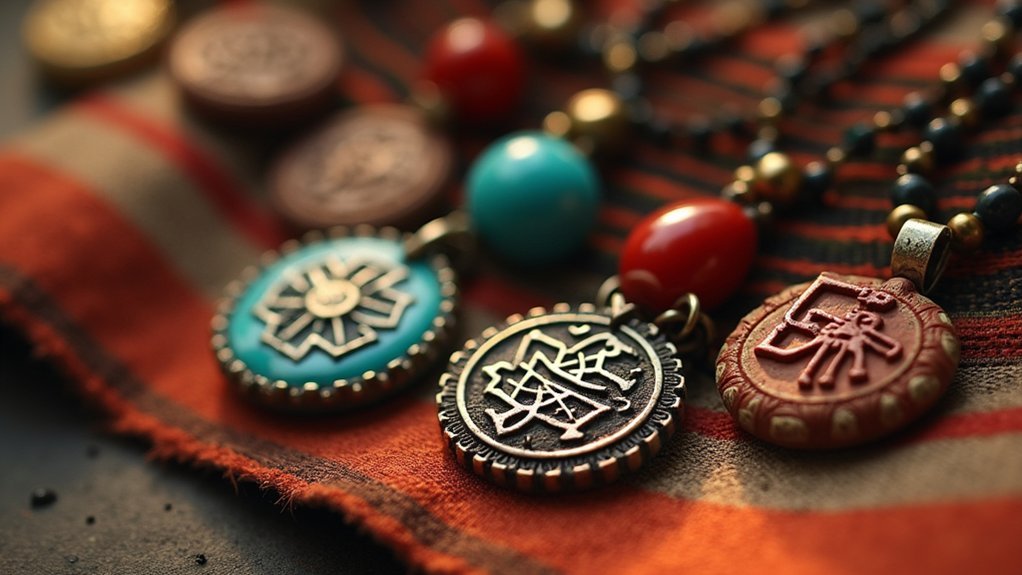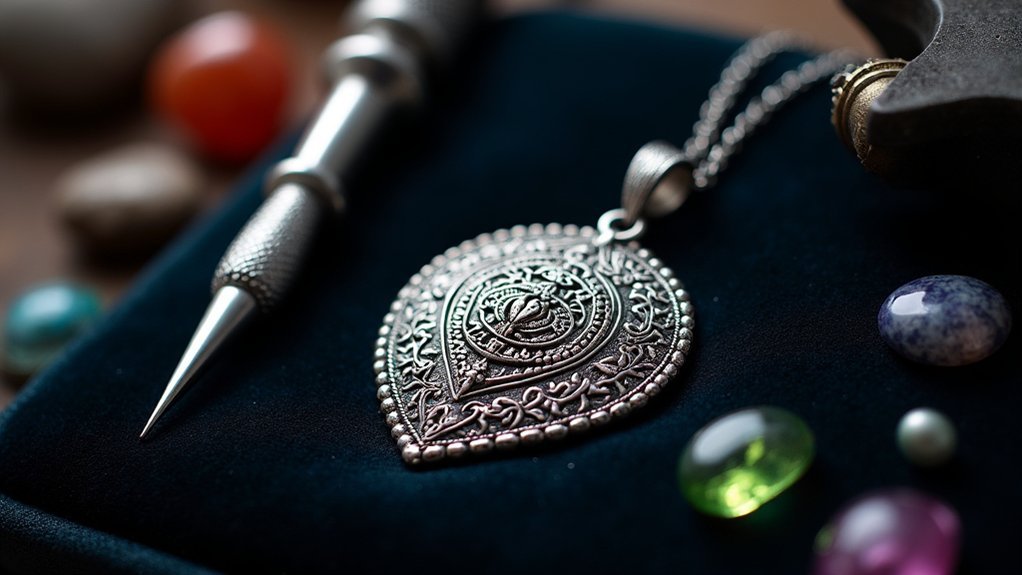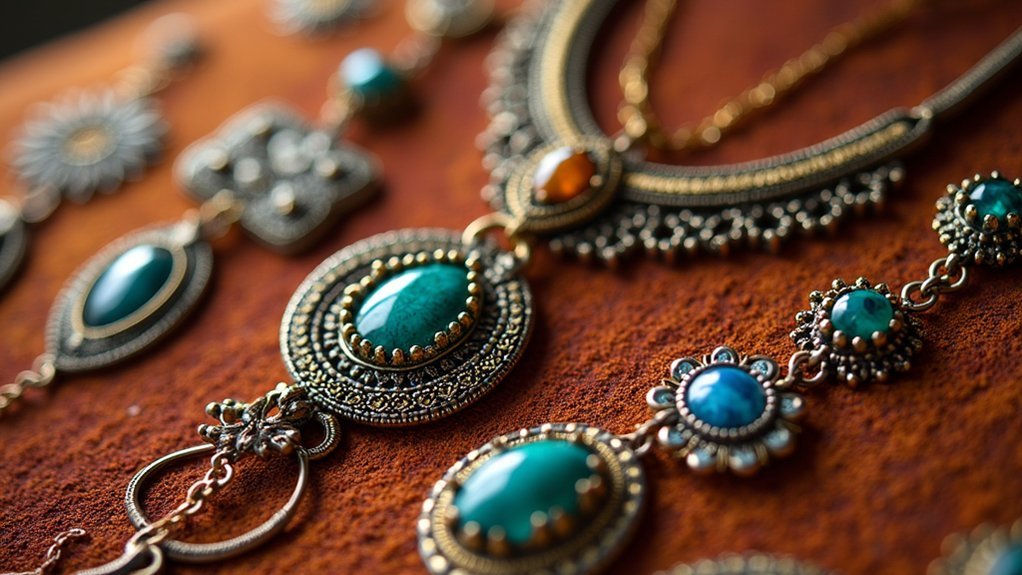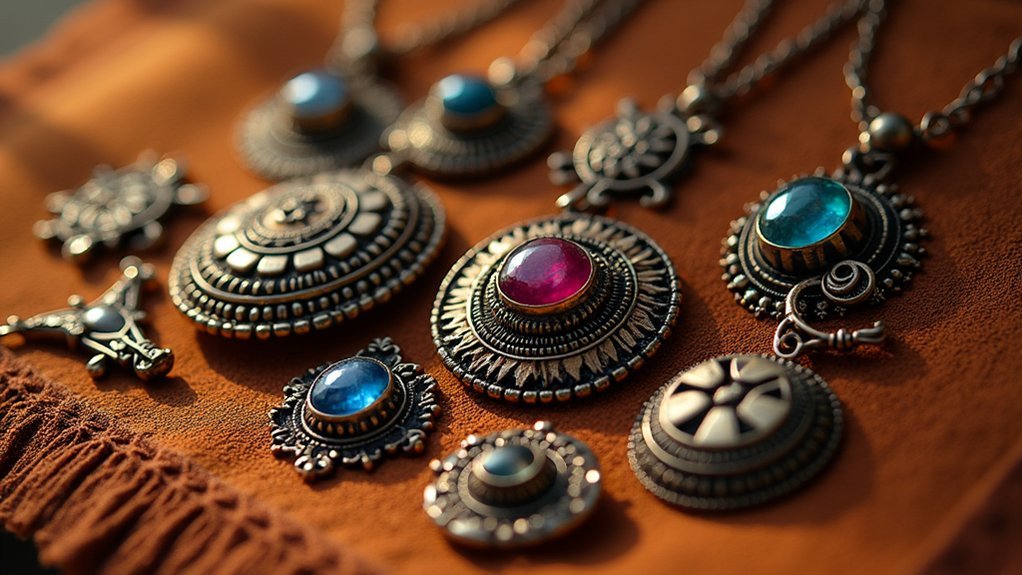You’re holding more than metal and stone when you create culturally meaningful jewelry—you’re crafting a bridge between ancient wisdom and modern expression. Each symbol carries centuries of sacred significance, from protective amulets to spiritual emblems that’ve guided communities through generations. But there’s a delicate balance between honoring these traditions and avoiding cultural appropriation. The difference lies in understanding five essential principles that’ll transform your approach to designing pieces that truly respect their origins.
Research Traditional Symbols and Their Sacred Origins

When designing jewelry with cultural significance, you must first dive deep into the historical roots and sacred meanings behind traditional symbols.
Start by researching ancient beliefs and practices that gave birth to these powerful designs. The Tree of Life appears across cultures, symbolizing interconnectedness and life’s cycles in jewelry design.
Ancient symbols carry profound spiritual power that transforms simple jewelry into meaningful talismans connecting wearers to timeless cultural wisdom.
The Hamsa hand from Middle Eastern traditions offers protection and blessings, with meanings varying by region.
Native American symbols like the Thunderbird represent strength and spiritual protection rooted in nature-based beliefs.
The lotus flower holds sacred origins in Hindu and Buddhist cultures, embodying purity and enlightenment.
Understanding these cultural significance layers guarantees your designs honor their traditional symbols respectfully and authentically.
Choose Authentic Materials That Honor Cultural Heritage
After you’ve researched traditional symbols, selecting authentic materials becomes your next essential step in honoring cultural heritage through jewelry design. You’ll need to choose materials that carry cultural significance and support traditional craftsmanship.
| Culture | Traditional Materials |
|---|---|
| Chinese | Jade, gold, pearls |
| Native American | Silver, turquoise, shells |
| Mediterranean | Gold, coral, precious stones |
| African | Bronze, bone, seeds |
| Celtic | Silver, amber, stones |
Source materials through ethical practices that support artisan communities. Incorporate organic elements native to each culture’s geographical region. Use culturally significant techniques like filigree or beadwork. Collaborate directly with cultural artisans to understand which materials hold deeper meaning. This approach guarantees your designs authentically represent heritage while respecting traditional methods.
Master Time-Honored Craftsmanship Techniques

Though selecting authentic materials forms your foundation, you’ll truly honor cultural heritage by mastering the time-honored craftsmanship techniques that give each piece its soul.
These techniques passed down through generations carry the essence of different cultures within their intricate processes.
- Master filigree metalworking to create delicate, lace-like designs that showcase generational artisan knowledge and cultural storytelling through metal.
- Learn mokume-gane from Japanese tradition, combining different metal layers to achieve wood grain patterns that reflect cultural aesthetic principles.
- Practice granulation techniques by fusing tiny metal balls onto surfaces, following ancient Etruscan goldsmithing methods that enhance artistic expression.
Each method you master enables you to create a piece that speaks authentically to its cultural origins, transforming simple jewelry into meaningful artifacts that preserve and celebrate heritage.
Balance Contemporary Appeal With Cultural Respect
While mastering traditional techniques provides authenticity, you must carefully navigate the delicate balance between honoring cultural heritage and creating jewelry that resonates with contemporary audiences.
Research the cultural significance of every motif and symbol you incorporate, ensuring accurate representation while avoiding appropriation. Collaborate directly with artisans from the cultures you’re drawing inspiration from to gain authentic insights and understanding.
Your custom jewelry should blend traditional craftsmanship methods like filigree or granulation with contemporary materials and aesthetics. This approach honors cultural techniques while appealing to modern sensibilities.
The key is creating pieces that allow for personal expression while maintaining cultural integrity. Your designs must remain accessible to wider audiences without compromising the authentic essence of their cultural roots.
Collaborate With Community Members for Accurate Representation

Before you begin sketching designs or selecting materials, establish meaningful partnerships with community members who possess deep cultural knowledge and lived experience.
When you collaborate with community members, you’ll gain invaluable insights into cultural symbols and their authentic meanings, preventing misrepresentation and appropriation.
Here’s how to foster authentic representation:
- Consult with cultural elders who can explain the significance of traditional motifs and their proper usage contexts.
- Partner with local artisans to learn heritage techniques and understand which symbols carry sacred or restricted meanings.
- Organize design workshops where community members can share stories and provide feedback throughout your creative process.
This collaborative approach guarantees your jewelry honors cultural narratives while supporting local economies through fair trade practices and shared creative ventures.
Frequently Asked Questions
What Is the Cultural Significance of Jewelry?
You’ll find jewelry carries deep cultural meaning, reflecting heritage, status, and identity. It’s integral to ceremonies, marks life changes, expresses political messages, and connects you to ancestral traditions while celebrating personal beliefs.
What Makes a Good Jewelry Design?
You’ll create exceptional jewelry by balancing aesthetics with functionality, choosing quality materials, ensuring comfortable wearability, and incorporating meaningful elements that resonate with your intended audience while maintaining clean, timeless design principles.
What Culture Wears a Lot of Jewelry?
You’ll find that Indian culture features extensive jewelry wearing, especially during weddings and festivals. Women traditionally wear elaborate gold pieces from head to toe, symbolizing marital status, prosperity, and cultural identity.
What Does Jewelry Symbolize?
Jewelry symbolizes your identity, cultural heritage, and personal beliefs. You’ll find it represents life changes, spiritual protection, marital status, and social movements. It’s your way of expressing values, commemorating milestones, and connecting with ancestral traditions.
In Summary
You’ll create meaningful jewelry that bridges past and present when you honor cultural traditions through careful research and authentic materials. By mastering traditional techniques and collaborating with community members, you’re ensuring your designs carry genuine significance. Remember, you’re not just crafting accessories—you’re preserving heritage and telling stories through wearable art. Your commitment to cultural respect while embracing contemporary appeal will result in pieces that truly resonate with deeper meaning.





Leave a Reply